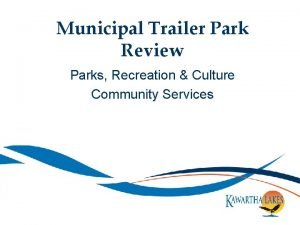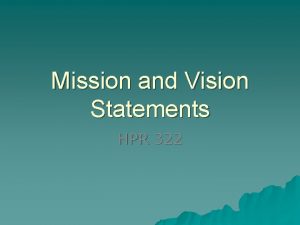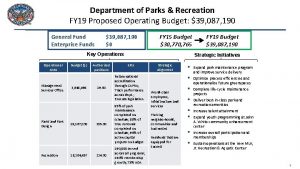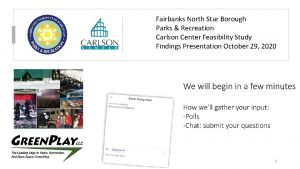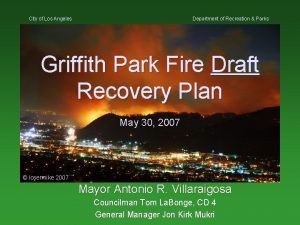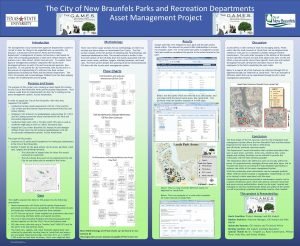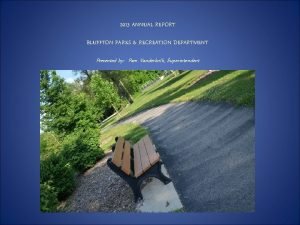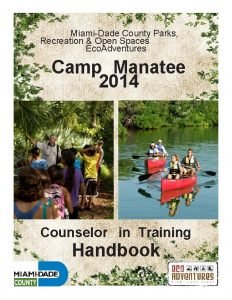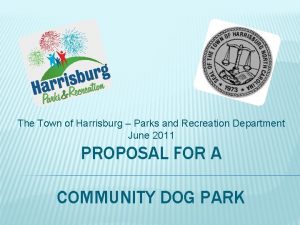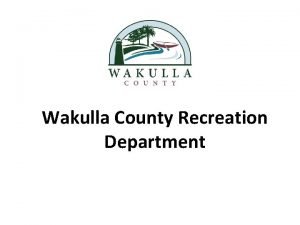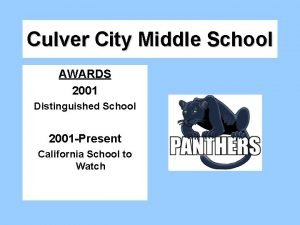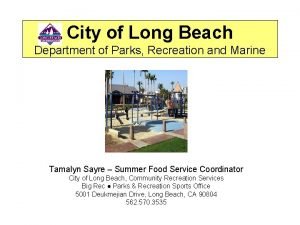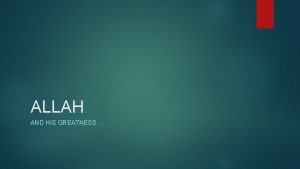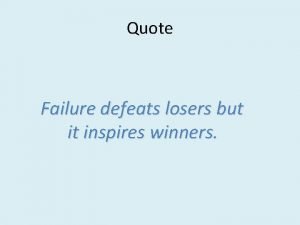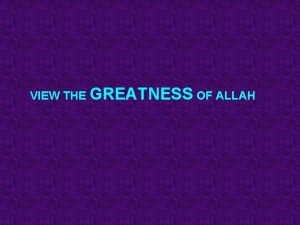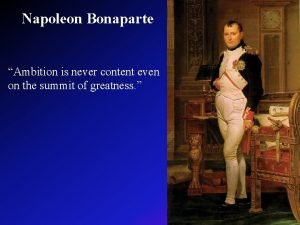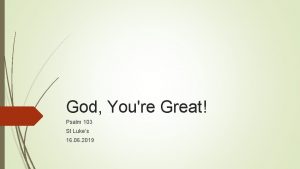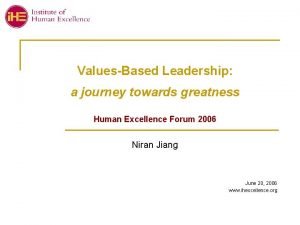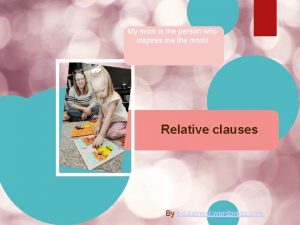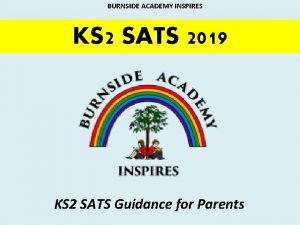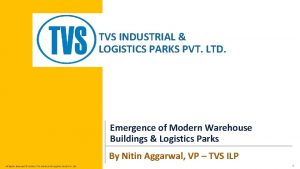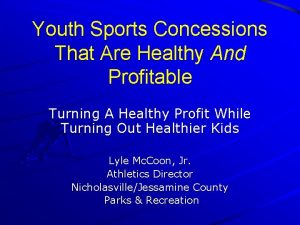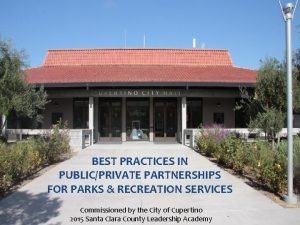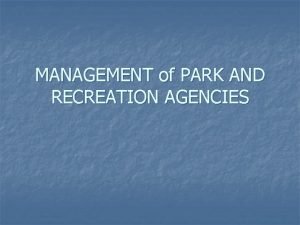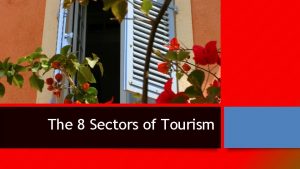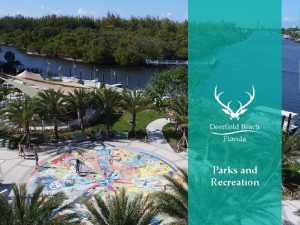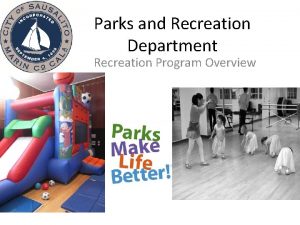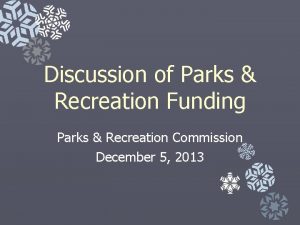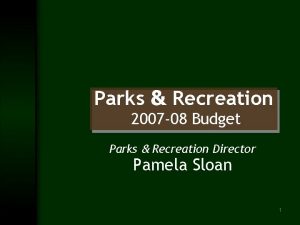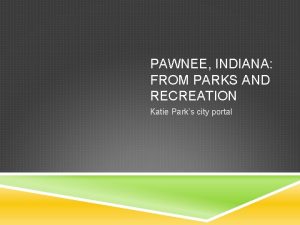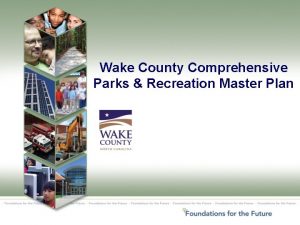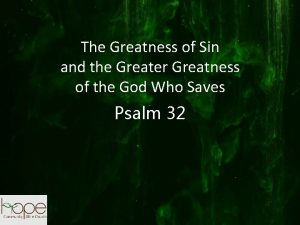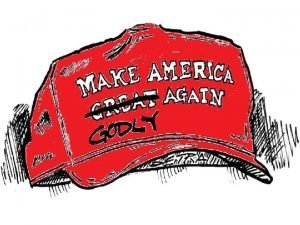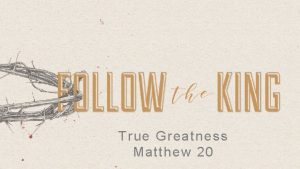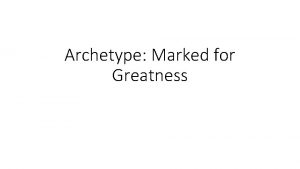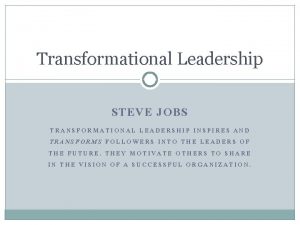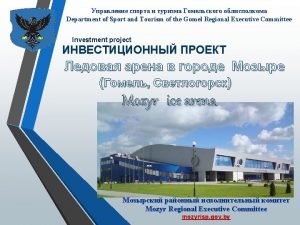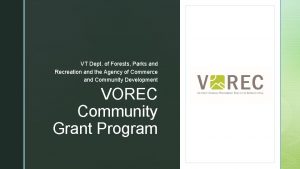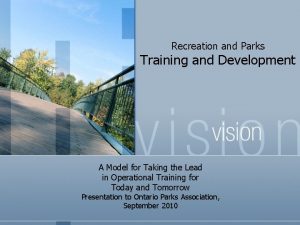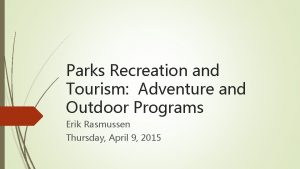Leadership Inspires Greatness in the Parks and Recreation


































- Slides: 34

Leadership Inspires Greatness in the Parks and Recreation Industry 75 th Annual Vermont Conference on Recreation October, 2018 BARBARA HELLER BARBARA@HELLER. COM

OBJECTIVES 1. To provide information on the top five ideas for building and sustaining effective and successful organizational leadership. 2. Increasing overall leadership effectiveness

Five Attributes for Discussion Strategy and Direction Leadership System Organizational Culture Investment in People Focus on the Customer

Strategy and Direction

How Do You Establish Direction?

Direction Strategy and Execution Strategic and Operational

Strategy Process Strategy as a core competency of senior leaders Timing/Timeframes (short, medium, and long, 3 -5 years) Getting out of the weeds Fitting it into workload Sequencing and timing of needs assessment, strategy, master planning Fits within a city’s plan

Strategy and Direction How to create strategic direction? Mission, vision and values Strategic plans and master plans Mission Vision Values Demographics and Community Needs Organizational Performance Key Strategy Influencers Strategic direction

Mission, Vision, Values

Strategy Development Input Take into account: Organizational SWOT Changes in customer preferences, trends Ability to implement strategy; financial resources Technology changes Community demographics Needed workforce capacities Short and longer term goals Strategy deployment

Strategy Implementation

Strategic Direction of Parks and Recreation?

Leadership System ATTRIBUTES, DIRECTION

LEADERSHIP Vision/direction/strategy Empowerment and engagement Communication skills External focus Creating accountability and high performance The art of coaching and feedback Change management and innovation

Google’s Project Oxygen More than 10, 000 observations about managers Ø Empower your team and don’t micromanage Ø Express interest in team members’ success and personal well-being Ø Don’t try to be popular; be productive and results oriented Ø Be a good communicator and listen to your team Ø Help your employees with career development Ø Have a clear vision and strategy Ø Have key technical skills Ø Be a good coach

Lack of personal mastery and self-awareness Micro management Being risk averse Running roughshod over subordinates Being cold, aloof, or arrogant Focusing on empire building Too concerned with getting ahead Not delineating low and high priorities Pushing too hard and burning out Being rigid or difficult to influence Being too concerned with status, power Having an inflated sense of their own importance Generally lacking integrity

Organizational Culture WHAT MAKES IT GREAT

Cultural Competency At the organizational level, cultural competence refers to a set of congruent behaviors, attitudes, and policies that enable an agency to work effectively.

Culture Shared Pervasive Enduring Implicit

Signs of a Great Culture?

Reinforcement of Culture Measurement of current culture • Organizational Culture Inventory by Human Synergistics, as an example Aspirations for desired culture Role of values System alignment • Recruit/hiring • Orientation • Reward and recognition

Workforce Environment HOW TO CREATE

Workplace Environment Organizational efficiency and effectiveness Importance of trust Assessing workforce capabilities Workplace health, security, safety

Using a scale of 1 to 5 where 1 means very true and 5 means very untrue, rate how true these statements are for your organization. 1. There is ongoing rework 2. Firefighting is a common phenomenon in the organization 3. Management inspection (micro management) 4. Standard processes do not exist in the organization 5. Processes are static and do not get improved 6. Performance of processes is not measured or monitored 7. Excessive e-mail and other “e” wastes 8. Processes require multiple signatures or approvals 9. Promotional material reaches the customer too late 10. Workspace is cluttered and disorganized

Creating a Trusting Environment Balancing advocacy and inquiry Making it safe to discuss undiscussables Congruency between what you say and what you do Openness and transparency Don’t micro-manage Driving out fear The meeting after the meeting

Organizational Trust One of the most important attributes for an organization. Important to measure in employee satisfaction surveys. Areas to consider: q Being treated fairly q Level of trust between management and nonmanagement personnel q Level of trust among people you work with q Degree to which you can depend on others

Assessing Workforce Capabilities Strategy dictates human resource planning Allocation of labor dollars to higher, greater need Position competencies

Work Environment Creative office space for collaboration Flexible schedules Don’t hire any jerks Recognition Sense of care Choose accountability over popularity Challenges of part-time staff connection

EMPLOYEE INITIATIVES Employee education, training and development Future staffing and skill sets Engagement and accountability Employees leave for the following reasons: poor leadership, the feeling of having no impact, no recognition, not learning on the job, don’t like coworkers, money

EMPLOYEE INITIATIVES Culture Club Social stuff Team based approaches Communication as a process Strength finders Help days Let’s stop doing it meetings; smart and stupid meetings Reward and recognition systems Career development Coaching and feedback

Focus on the Customer KNOWLEDGE, CUSTOMER SATISFACTION, RELATIONSHIPS

Customer Focus It’s more than offering customer service training Insular focus? How much attention is given to the external customer? How much do you know about your customers? How do you measure satisfaction?

HOW DO YOU KNOW IF IT’S REALLY WORKING/Results Internal customer satisfaction External customer satisfaction Employee satisfaction Organizational results Financial results Good brand image Relevancy in the community

Summary, Discussion, Questions For more information, contact Barbara Heller/224. 456. 6934 Barbara@heller. com/www. hellerhell er. com
 Parks sunbury
Parks sunbury Parks and recreation trailer
Parks and recreation trailer Parks and recreation vision statement examples
Parks and recreation vision statement examples Parks and recreation organizational chart
Parks and recreation organizational chart Fairbanks parks and recreation
Fairbanks parks and recreation City of los angeles department of recreation and parks
City of los angeles department of recreation and parks Parks and rec new braunfels
Parks and rec new braunfels Bluffton parks and recreation
Bluffton parks and recreation Miami eco adventures
Miami eco adventures Harrisburg park and rec
Harrisburg park and rec Food stands
Food stands Fayetteville cumberland parks and recreation
Fayetteville cumberland parks and recreation Culver city parks and recreation after school program
Culver city parks and recreation after school program City of long beach parks and rec
City of long beach parks and rec Allah's greatness and power
Allah's greatness and power Failure defeats losers but inspires winners
Failure defeats losers but inspires winners Greatness of allah
Greatness of allah Napoleon bonaparte's ambition
Napoleon bonaparte's ambition Greatness of god
Greatness of god Greatness
Greatness Journey towards greatness
Journey towards greatness A great teacher inspires essay
A great teacher inspires essay My mom inspires me
My mom inspires me Burnside academy
Burnside academy Transactional vs transformational leadership
Transactional vs transformational leadership Family and morale welfare and recreation
Family and morale welfare and recreation Situational leadership vs adaptive leadership
Situational leadership vs adaptive leadership Situational leadership vs adaptive leadership
Situational leadership vs adaptive leadership Tvs industrial & logistics parks pvt ltd
Tvs industrial & logistics parks pvt ltd New braunfels parks and rec
New braunfels parks and rec Jessamine county parks and rec
Jessamine county parks and rec Cupertino parks and rec
Cupertino parks and rec Management of park and recreation agencies
Management of park and recreation agencies Elizabethan era recreation and sports
Elizabethan era recreation and sports Sectors in tourism
Sectors in tourism

